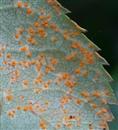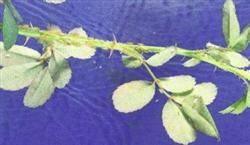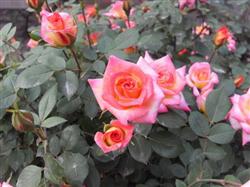Symptoms and control methods of rose rust

Rose rust occurs in countries with suitable climate all over the world. It sometimes causes serious harm to rose cultivated in greenhouse. In addition to rose, the disease can also infect roses, roses and other flowers. There are many kinds of pathogens of rose rust, including 10 species reported abroad and 3 species known in China. Among them, Phragmidiummontivagum (Pers.) Schlecht. Is the main pathogen, which belongs to the subphylum of fungal basidiomycetes and polyspore rust. Symptoms of the disease are mainly harmful to leaves, petioles and buds, as well as shoots, calyx and fruits. In spring, a small orange blister appeared on the front of the damaged leaf, which was the sexual spore organ of the pathogen; later, a slightly raised orange spot appeared on the back of the leaf, that is, the rust spore apparatus, which broke through the epidermis and scattered orange rust spores after maturation. There is often a faded ring around the disease spot. Soon, orange summer spore powder piles were produced on the back of the diseased leaves. In the late growing season, a brown to black small powder pile of teliospore was formed in the part where the summer spore pile was formed. The damaged parts of the plants often bulge or overgrow or show abnormal shape, and the leaves of the susceptible plants fall early and grow and decline. The pathogen overwintered in diseased buds or diseased sites, or overwintered with winter spores on withered branches and fallen leaves. The pathogen is a single host parasitic rust, that is, five stages in the life cycle occur on the same host. In the following spring, teliospores germinate and produce basidiospores, and basidiospores germinate and invade new leaves to form primary infection. In the growing season, summer spores spread by wind and rain, invade by stomata, and can be re-infected many times. Epidemic characteristic temperature plays a key role in the epidemic of the disease. The most suitable temperature for teliospore germination was about 18 ℃, but it was difficult to form spores at 25 ℃. The optimum temperature for rust spore germination was 15-21 ℃. Although most of the summer spores could germinate at 9-25 ℃, the optimum temperature for germination was 18-21 ℃. Water is also very important for the germination of rust spores and summer spores. Generally, spores can germinate only when there is free water. Therefore, the rainy and foggy areas with warm seasons are beneficial to the occurrence and epidemic of the disease, while the occurrence is lighter in areas with high temperature in summer or cold in winter. Prevention and treatment method ① to reduce the source of infection: combined with pruning, collection of diseased remains, and centralized destruction. ② does not plant diseased seedlings and uses nitrogen fertilizer rationally. ③ chemical control: after pruning in early spring, spray Baume 2-5 degree stone sulfur mixture. Spray 50% mancozeb 500 times solution, or 97% rust sodium 250-300 times solution, or Baume 0.2-0.4 degree stone sulfur mixture, or 50% dinitrate powder 200 times liquid, spray once in 10-15 days, spray 2-3 times. Or 20% verapamil EC 800 times, spray once every 30 days.
- Prev

Control methods of APHIS gossypii
APHIS gossypii belongs to Homoptera and Aphidae. Nymph aphids, adult aphids harm rose, rose, ten sisters, etc., due to the effective stagnation of the growth of young leaves and buds, it is not easy to stretch, and the ornamental value is often affected by feces adhering to the leaves. First, the morphological characteristics of wingless parthenogenetic aphids are larger, ovoid and 4.2 mm long.
- Next

Rose lobular disease
Symptomatic rose lobular disease is a common physiological disease in northern China. Lobular disease occurs on young shoots and young leaves, and the disease is more obvious when the spring rose sprouts. The diseased branches germinated later, the leaves were narrow and slender, the leaf edges were upward, the quality was hard and brittle, the leaf color was light yellowish green, and the leaf color was uneven.
Related
- Fuxing push coffee new agricultural production and marketing class: lack of small-scale processing plants
- Jujube rice field leisure farm deep ploughing Yilan for five years to create a space for organic food and play
- Nongyu Farm-A trial of organic papaya for brave women with advanced technology
- Four points for attention in the prevention and control of diseases and insect pests of edible fungi
- How to add nutrient solution to Edible Fungi
- Is there any good way to control edible fungus mites?
- Open Inoculation Technology of Edible Fungi
- Is there any clever way to use fertilizer for edible fungus in winter?
- What agents are used to kill the pathogens of edible fungi in the mushroom shed?
- Rapid drying of Edible Fungi

